One man’s trash is another man’s treasure, so they say. This idiom is equally prevalent inside the vast landscape of the World Wide Web as it is in everyday life.
For over 20 years now, domain names have been fetching some impressive prices whenever the right buyer comes along. In fact, GoDaddy reports that the website name: carinsurance.com is the most expensive domain in history – selling for an astounding $49.7 million in 2012.
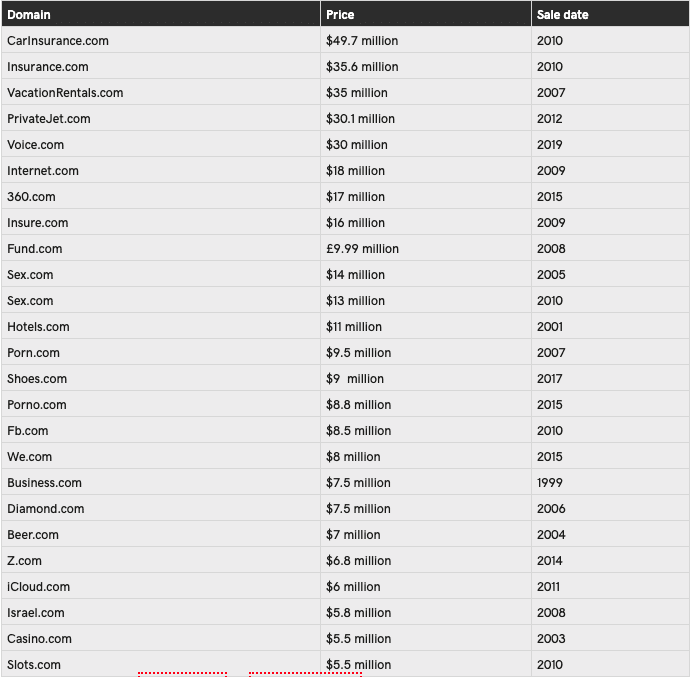
Image Source: GoDaddy
Now’s probably a good time to say that if you’re holding on to a domain that you no longer need, or are interested in finding out the value of your domain, the chances are that you won’t be looking at a multimillion-dollar retail price – but you could well be sitting on a handsome profit.
Perhaps you bought a domain name many years ago with the intention of creating your very own functioning website, only for other commitments to get in the way, leaving your URL sitting dormant. Or maybe your existing domain name isn’t relevant anymore and you’re looking to transfer to a fresher one. Either way, there’s plenty of options out there if you’re interested in cashing in on a purchased domain name.
Here’s a comprehensive guide on how to sell domain names to willing buyers, as well as three of the very best platforms to leverage doing so:
The domain marketplace
The marketplace for domain names has expanded widely in recent years with the arrival of new domain extensions like .io, .info, .store and the like. This has opened the door to companies gaining appealingly short names for their websites without paying more for the much-sought-after .com top-level domain (TLD) extension.
However, according to Domain.com, there’s no shortage of TLDs for users to tap into, which has made certain addresses relatively cheap for buyers. Interestingly, TLDs like ‘.protection’ and ‘.security’ are selling for thousands of dollars, but the cheaper end of the spectrum is populated by more general and nonsensical names like ‘.xyz’, ‘.info’ and ‘.world’ – all selling for $2.99 each.
When it comes to selling on names, the originals non-country-specific TLDs of .com and .net are particularly popular, due to their widespread accessibility and familiarity with users online. Here’s a deeper look at determining the value of any domain names you may be in possession of:
Determining value
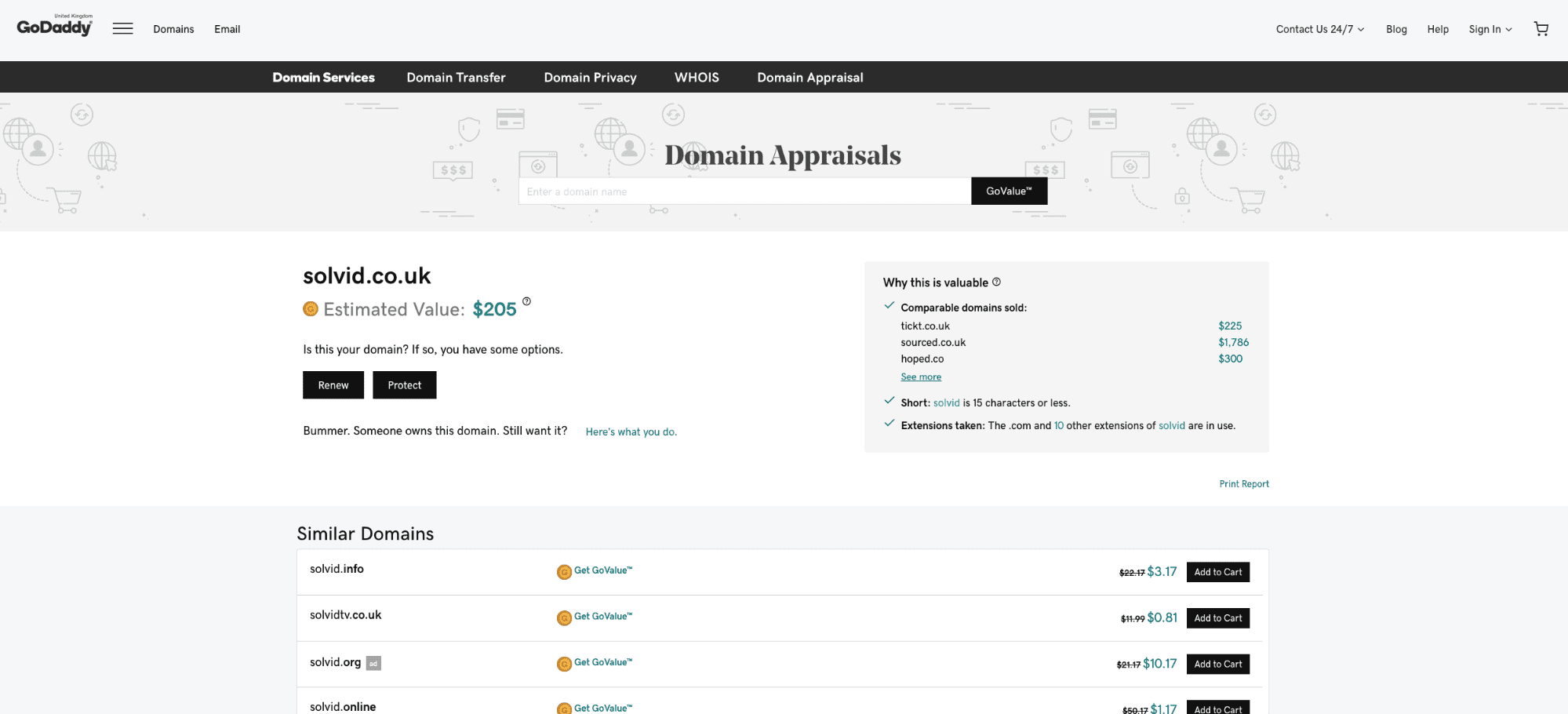
Of course, in order to sell your domain, you’ll first need to gain an understanding of its value. The domain name marketplace is littered with overpriced TLDs by owners with little understanding of how their name should be priced up. Being in possession of a TLD for a long time can mean that it will sell for a healthy price when it eventually arrives on the marketplace, but there’s no guarantee that its price will appreciate over time.
There are, however, some good indicators as to how much value your domain could hold:
- Firstly, is your domain a .com, or does it have a less commonplace suffix? A .com domain will often carry a higher price.
- Secondly, is your domain name short? Or does it contain a lot of words? Shorter domains tend to sell for a lot more.
- Thirdly, is your domain easy to spell? Or does it have a common abbreviation? Domain names that include commonplace words or regular abbreviations will fetch a higher price.
- Finally, do you have hyphens or other elements in your domain? Domains that contain fewer words (preferably even one), and don’t include hyphens will sell for much more.
There are plenty of tools to help you determine the value of your website, GoDaddy runs a free Domain Value and Appraisal Tool that automatically assesses yours or anyone else’s domain and returns an approximate quote. However, as these are only approximations, it’s worth doing a little bit of market research to see what similarly named domains have sold for.
A good tool for comparing and contrasting the values of similar domain names can be found at Namebio.
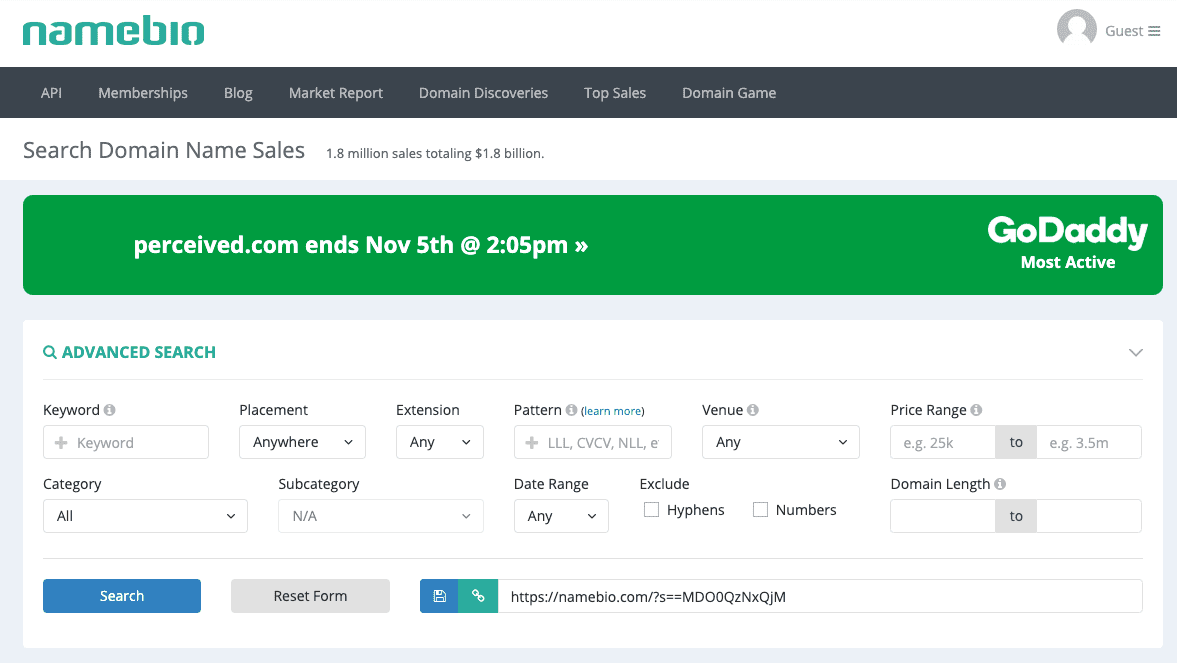
Since the rise of SEO, website URLs that contain common search terms have begun to increase in value, so it’s worth taking a moment to check whether a website you may have purchased many years ago has gained an added air of relevance in recent times.
Website flipping has become an increasingly popular money making method ever since the Dot Com Boom, and if you’re looking to go down the trading route, then it’s vital that you keep track of emerging trends when it comes to pricing. Be patient and observe how the domains market is behaving over longer periods of time. When you identify a trend, it’ll pay dividends in paving the way for smarter informed investments.
Selling options
Once you’ve attained a strong idea of your domain’s market value, it’s time to begin the search for a willing buyer.
There are actually numerous options when it comes to finding a way to sell a domain name online. By far, the most popular way of buying and selling domains is currently through the medium of dedicated platforms like Flippa and Sedo.
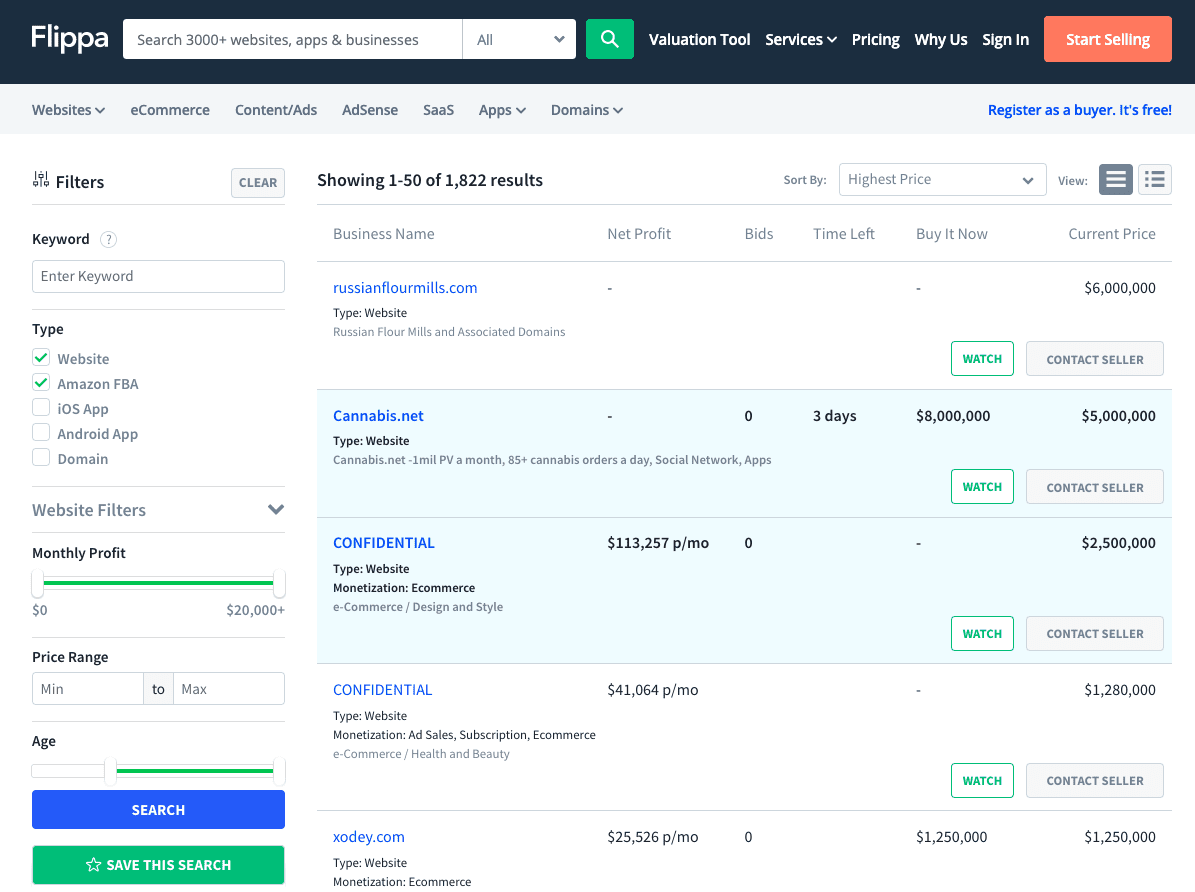
These digital marketplaces help website owners to advertise their domain name to interested buyers and accept offers from prospective suitors. Online domain marketplaces are ideal if you’re interested in flipping domain names for a profit – but be warned, there’s plenty of competition out there when it comes to the trading of top-level-domains.
We’ll get into the specifics of the industry’s most prominent domain name marketplaces a little later within this guide. But for now, let’s explore some other options available to users wishing to sell their website addresses for good money.
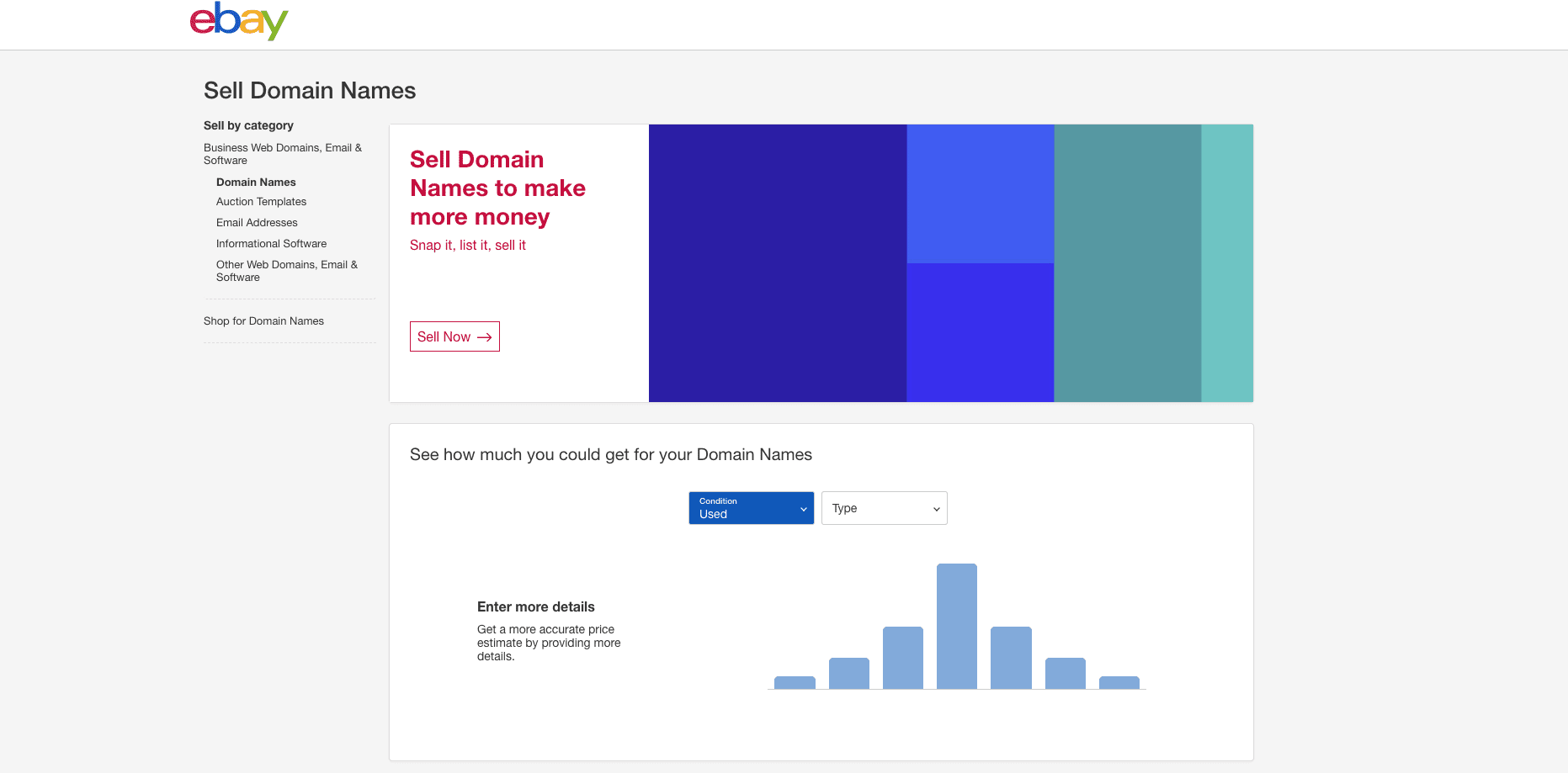
One innovative option for users looking to sell, and prospectively buy, domain names are available through eBay’s dedicated domain name marketplace.
Users can list their domain names along with a description and desired price tag on eBay and interact with interested buyers.
Given that eBay is a world-renowned institution, this particular aspect of the online marketplace could be a great bet when it comes to finding interested buyers for your domain name.
There are also more traditional options available for domain name sellers. Namely, you can simply advertise the sale of your domain…on your domain. By placing a noticeable ‘for sale’ sign on your website’s homepage, you’re effectively putting it in the shop window for prospective buyers who have already demonstrated their interest by navigating on to your URL.
The act of advertising your domain by placing a ‘for sale’ sign on the page itself is relatively old-fashioned, and won’t reach quite the same levels of audience, but it is free to list and could certainly be worth a try.
Get your contacts in order
We all love our privacy, but when it comes to selling websites, having your details accessible online can be significant in finding a buyer for your domain name.
Sure, you can list your domain name on an online marketplace, or stick a big sign on your homepage advertising its availability. But what if a prospective buyer doesn’t actively look on domain marketplaces and has instead identified your domain name as a TLD of interest without visiting your homepage first?
There are lots of people out there who use WHOIS lookups to find out the finer details of specific domain ownership records. Some website hosts offer privacy when it comes to displaying ownership information online – and rightly so. But in the case of making yourself available to receive offers for your domain names, it can make all the difference if you take a moment to ensure that your information is correct and accurate on WHOIS to ensure the best chances of finding a buyer.
To update your WHOIS contact information, the process usually differs based on which host you’re using, but this handy guide can provide a healthy level of insight to help you along.
Remember that if you’re interested in selling your domain name, it’s imperative that you make yourself available and accessible to prospective buyers. By updating your contact information on WHOIS, you’re opening the door to a potentially wide array of people who could be interested in your domain name.
Prepare your listing
Whether you’re planning to list your domain name on a dedicated marketplace like Flippa, Sedo or Afternic, or opting to use a more recognisable general platform like eBay – it’s important to make sure your listing is well optimised for buyers.
Too many domain owners simply upload their URL on an online marketplace and leave it at that. Be sure to boost your chances of drawing in buyers by adding a little flair to your listing along with an accurate and honest description.
The best domain sellers have a habit of striking a balance when it comes to describing their URL. It’s vital that you’re in no way misleading about the finer details, but it does help to emphasise the positives of your address.
For example, does your TLD already have existing traffic continually arriving? Is the domain notably old? Has it got any pre-existing domain authority?
All of these factors can enter the equation and add – or subtract – value for your domain name. Be sure to keep honest while promoting the good stuff. It’s also a good idea to take the metrics above into consideration when you’re calculating the asking price of your website. All websites have a sweet spot in their valuations that can attract interested bidders without being underpriced.
Sadly, with so many varying factors that can enter the mix when it comes to website valuations, it can be hard to figure out the true value of your domain – which is why it’s vital that you conduct a healthy amount of quote comparisons before deciding on a figure.
Payment options
In the domains marketplace, as in most other online marketplaces, there are two primary forms of selling your goods: through fixed-price purchases, or by holding an auction.
Both approaches carry some varying levels of appeal, and it can make a considerable difference to the buyers you attract depending on which type of selling process you decide on. When it comes to fixed-price selling, there’s certainly an appeal to many buyers, as they’ll be fully aware of the financial commitment they’re making.
However, an old-fashioned auctioning process holds plenty of charm too, and some buyers even prefer the somewhat more exciting approach of bargain hunting under the hammer. This mindset can sometimes play into your hands as a seller, and you’ll likely receive the highest fee for your domain name if two or more parties enter into an auction and end up competing for your domain name. Of course, there’s always a chance that taking your domain into auction could backfire and result in no interested buyers, too.
There are plenty of online market places that enable interested buyers to make a private offer for your website. This can be a lucrative method of selling your domain name too and paves the way for a range of private negotiations between interested parties.
It’s also important to consider the payment process you’ll be using to facilitate the sale of your domain. Naturally, buying domains works differently to buying your lunch from a supermarket, and there needs to be an intermediate point between yourself and the buyer to ensure both parties are protected during the purchase.
HostGator recommends that sellers utilise Escrow as a payment provider that ensures protection. An Escrow service essentially acts as a third-party that safely holds and processes funds on-demand once a mutual agreement has been achieved.
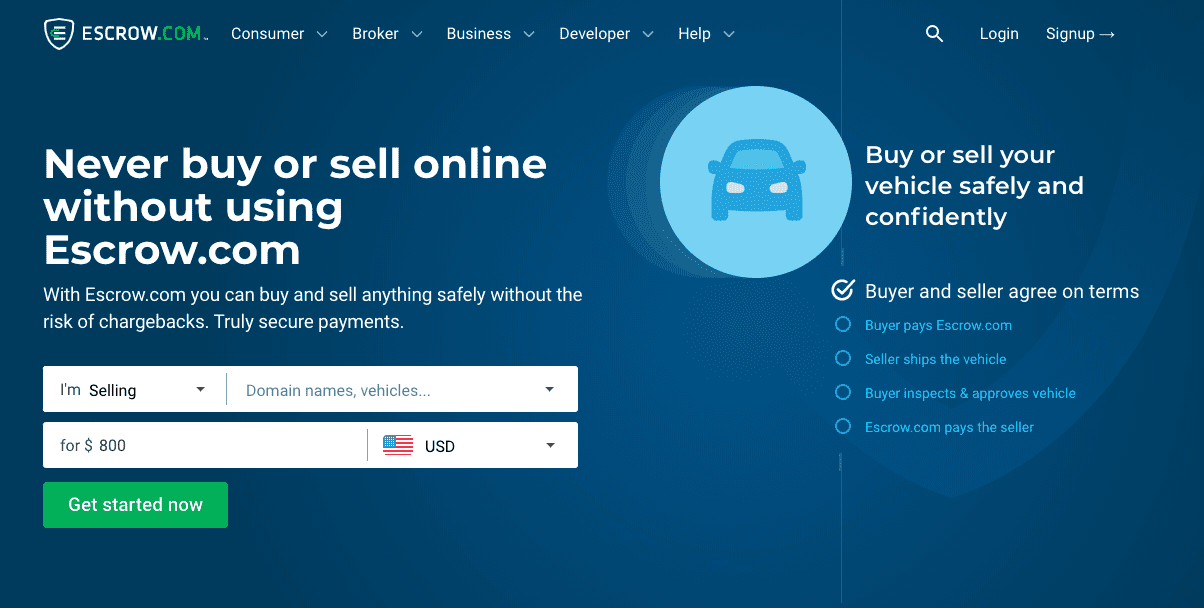
Some notable marketplaces, like Sedo, have Escrow built into their selling portal so that buyers and sellers can seamlessly process transactions risk-free.
However, it’s worth noting that Escrow will take a small cut of the final price in a sale. But this will probably be an amount worth paying to ensure that you receive the money that your domain name merits.
Transferring domains
If all goes well, your advertisement or market listing will be noticed by an interested buyer and payment can take place quickly and securely.
The onus will now be on you to successfully set up the transfer of your domain from your ownership to that of the buyer.
There’s no universal process that accounts for the transferring of domains, and this part of the transaction will depend largely on the way you’ve decided to sell your site. However, generally, the process will follow a similar pattern to the three-step guide listed below:
- The seller will submit a unique authorisation code to be shared with the buyer in order to start the transfer process.
- One the transfer is completed, the seller will be obliged to claim the agreed fee from Escrow – which would’ve been holding the funds until the domain officially changed hands.
- Finally, it’s important to double-check that the Escrow funds are fully accessible and available to cash in on. This step needs to be observed because there could be restrictions in place that demand funds stay in an Escrow account for a predesignated amount of time.
To reiterate, the steps above are a rough guide as to how transfers can take place between two parties that opted to use a secure payment system to facilitate this particular transaction. Fundamentally, most domain sales will require an authorisation code changing hands, so it’s vital that, as a seller, you keep this information safe and secure.
Comparing the market
Now that we’ve delved into the tricky world of domain name selling, and explored the processes involved with the transferring of websites and the conducting of payments, let’s take a look at the range of marketplaces available for sellers to list their domains.
Of course, the platforms below aren’t the only places to sell your website. There’s the good old-fashioned option of placing a ‘for sale’ sign for free on your homepage, and then there’s the prospect of using the internationally famous selling site eBay to handle the listing of your domain.
However, it’s fair to say that, because of the niche nature of buying and selling domain names, it’s highly recommendable that dedicated marketplaces are called upon as the best option to find a wider pool of buyers. Here are three of the most notable domain name marketplaces available today:
1. Flippa
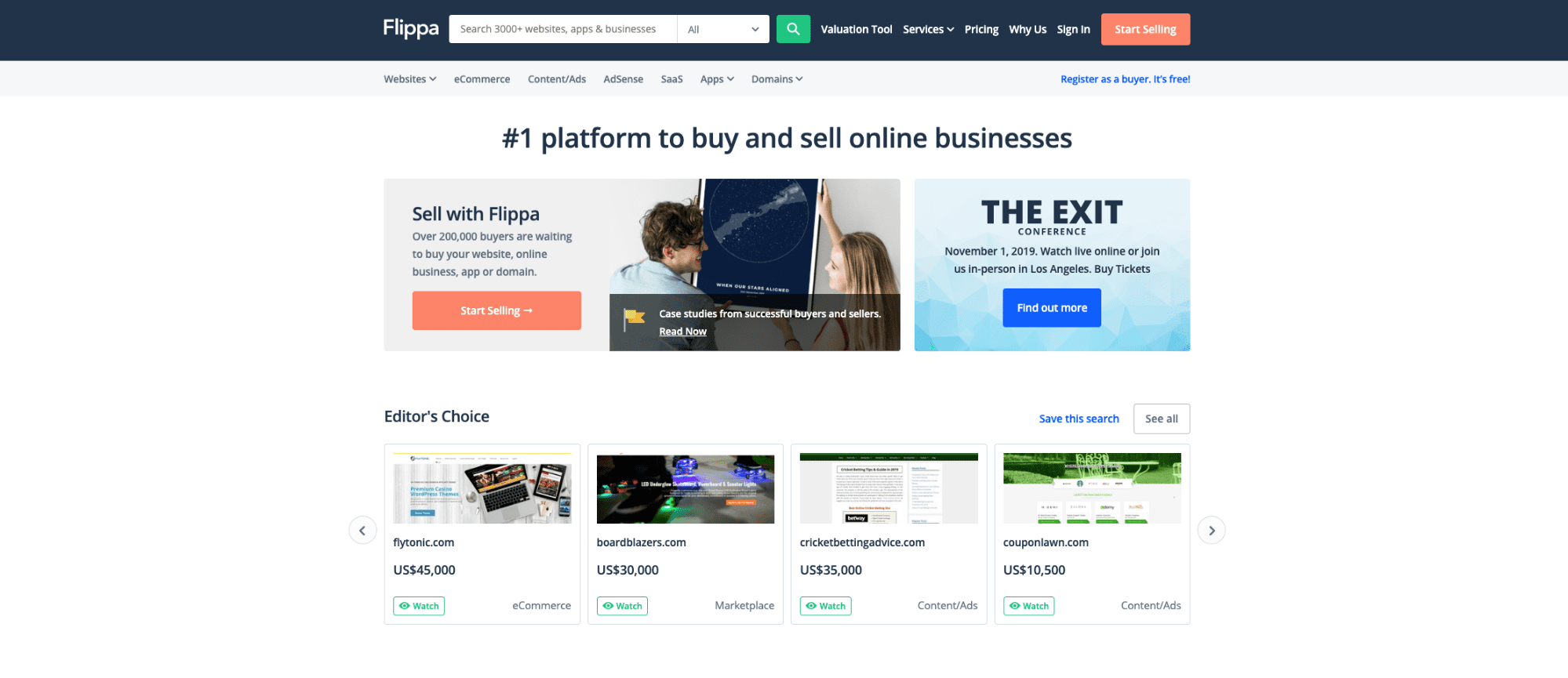
Flippa bill themselves as the “#1 platform to buy and sell online businesses,” and given the sheer volume of users they cater too and tools available on site, it’s hard to think of many other platforms capable of making a similarly bold claim.
So, let’s take a look at the cold stats to kick things off. There are 1.5 million on Flippa – over 200,000 of which are classified as ‘active buyers’ – that’s a pretty seismic pool of people to advertise your domain name to.
In the last week alone, nearly 15,000 bids were made on various Flippa auctions, and over $375 million worth of sales have already taken place on sight.
Flippa claims to be the oldest domain name marketplace online, and in a field where it pays to place your digital property under the noses of the widest range of prospective buyers – such statements mean a lot.
There’s more than meets the eye with Flippa, too. The platform’s built-in domain valuation tool takes all of five minutes to use and will return an approximate quote regarding the value of your website.
Flippa is also dedicated to allowing sellers to share a great wealth of information pertaining to the websites they list – including accurate categorisation, hosting platform, site age and net profit per month. Sellers can also add richly detailed information about the wider financial aspects of their domain, its current traffic rates and other helpful notes to interested buyers.
Flippa comes with a helpful, fixed price feature that tells sellers exactly how much they’ll be paying to showcase their domain online. While starter websites can be listed for a meagre cost of $15, established websites that are generating revenue require a payment of $49. Undeveloped domain names can be listed on Flippa for just $10.
If your website sells, then there’s also the matter of a ‘success fee’ to overcome. Domain names selling for between $1 and $499,000 will require a 10% fee once a sale has been made. Larger sales command lower fees.
Flippa also comes with the option for users to promote their listed domain names for an additional fee – costing between $65 and $950 depending on the level of exposure that you’re interested in.
All in all, Flippa is an extremely popular and well-established marketplace that’s geared towards the buying and selling of domains of all sizes. If you’re willing to pay to put your domain name under the noses of an array of prospective buyers – Flippa could be the place to go.
2. Sedo
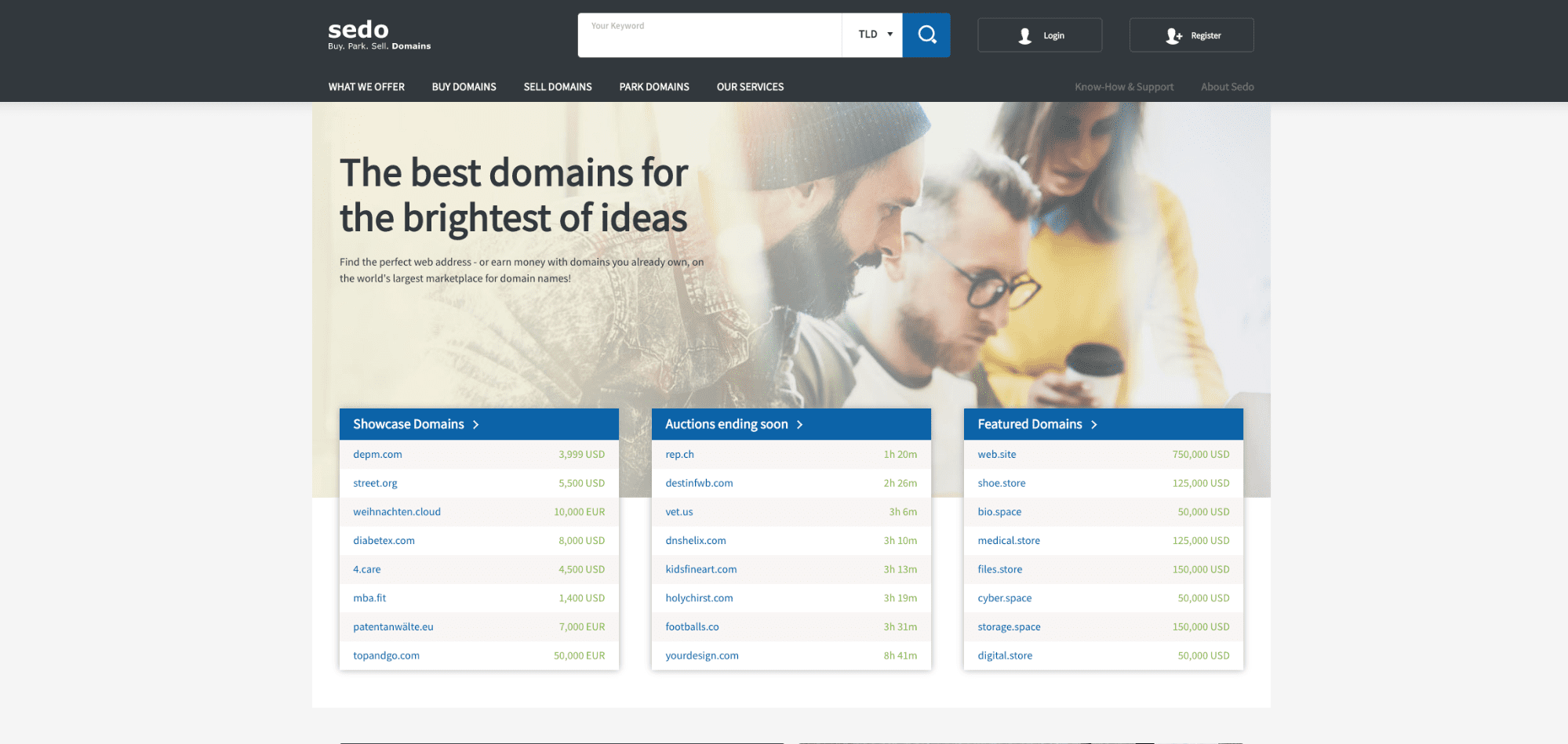
Sedo is one of the world’s favourite domain marketplaces. So much so that it has as much of a presence in Cologne of west Germany as it does in Boston of the United States.
The website claims that every-other domain transaction that takes place online is leveraged by Sedo – which firmly places it as one of the most popular choices for both buyers and sellers. In fact, Sedo has listed 19 million domains for sale and made 700,000 sales to a customer base of two million buyers worldwide since its founding all the way back in 1999.
There are plenty of reasons for Sedo’s success in the world of domain buying and selling over the past 20 years. The website’s offer of free registration, free transfers and free domain parking is certainly a perk that makes sellers’ lives easier.
The commission rate for the sale of parked domains is limited to a respectable 10% while a 3% handling fee for all sales also needs to be observed. By putting your website up for a marketplace auction, you’ll incur no fee with Sedo, however, if you choose to set up a direct auction a fee of €59 would be payable.
Overall, Sedo looks like a marvellous marketplace that’s optimised to aid sellers of websites that command lower values as well as higher ones. If you’ve recently discovered a parked domain that you’ve been sat on for the last ten years and you’re not sure whether it’ll bring you much in terms of fortunes, it feels like Sedo is the place to go.
Likewise, the website’s built-in features that focus on market trends and soon-to-be-closing auctions means that the marketplace is a hotbed for buyers and domain name flippers alike. Sedo certainly caters to everyone with their wealth of varied features and services.
3. Afternic
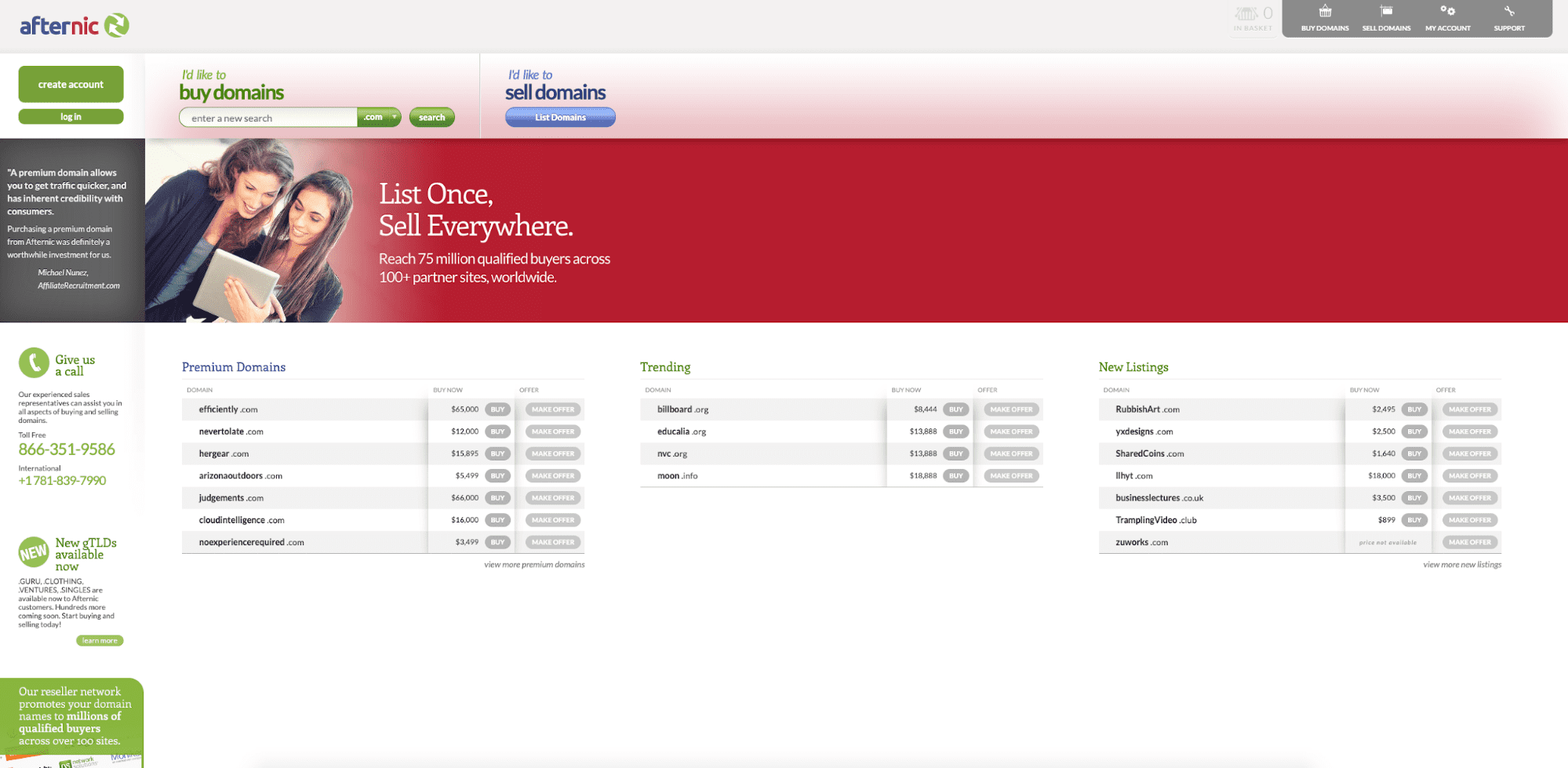
Founded in 1999, and also claiming to be the first domain marketplace in operation online, Afternic is an excellent and intuitive platform for both buyers and sellers of online real estate.
If you’re looking to advertise your domain to a wide pool of prospective buyers, Afternic could be the best solution out there. After all, 75 million qualified buyers visit the website each month.
Afternic claims to be a website that’s well optimised for sellers. The website promises ‘industry-high average sale prices through the largest global domain resale network of over 100 world-class partners’ online.
Afternic’s website itself is geared towards user experience. On the homepage, visitors are immediately greeted with multiple lists of domains – highlighting the best premium TLDs available on-site as well as trending and newly listed extensions.
The company has a dedicated appraisal team that can offer accurate valuations to sellers, and listing fees are relatively competitive too. Creating an account is entirely free for sellers, and sales commissions start at 20% for websites selling for between $0 and $5,000.
Overall, Afternic is an excellent site that puts sellers in touch with a massive range of prospective buyers at an understandable commission-based price. Its intuitive listing system means that most buyers will be able to locate the TLDs that interest them most with ease – Afternic even boasts a reputably positive customer service system.
Selling Domain Names FAQ
[sc_fs_multi_faq headline-0=”h3″ question-0=”Where to sell a domain name?” answer-0=”There’re a lot of platforms you can use to sell a domain name, including Flippa, Sedo and Afternic.” image-0=”” headline-1=”h3″ question-1=”How much do domain names sell for?” answer-1=”The price of a domain name can vary a lot, from $7 – $50,000,000.” image-1=”” headline-2=”h3″ question-2=”What determines the value of a domain name?” answer-2=”Factors like website traffic, keyphrase popularity, brandability, spelling and length play a vital role in valuing a domain name.” image-2=”” headline-3=”h3″ question-3=”What is the most expensive domain name ever sold?” answer-3=”According to GoDaddy, the most expensive domain ever sold is CarInsurance.com, which was sold for a whooping $49.7 million.” image-3=”” count=”4″ html=”true” css_class=””]

